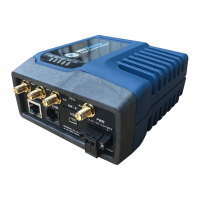MDS 05-6632A01, Rev. F MDS Orbit MCR/ECR Technical Manual 247
remote LAN networks on Orbit either statically (via manual configuration) or dynamically (by
running routing protocols like RIP/OSPF/BGP over multipoint GRE tunnel).
In a a hub-n-spoke deployment, where there is one hub router in central office and large number of
spoke router at remote sites, if site-to-site VPN setup is used then each spoke requires its own
tunnel configuration on the hub router. This can make hub configuration unwieldy. Also, everytime
a new spoke site is added to the deployment, the hub configuration needs to be updated. This can
become cumbersome from management perspective. DMVPN uses simgle multipoint GRE tunnel
interface on the hub which needs to be configured only once initially and is used to terminate all the
spoke tunnels. Addition of new spoke site doesnot require update of hub configuration if dynamic
routing protocols are used to add routes towards remote LANs at the spoke site. Although, DMVPN
technology is based on open standards, it was created by Cisco and hence is primarily only
supported by Cisco routers designed for use as IPsec hub routers.
Orbit
(Spoke)
HUB Router
LAN
10.0.2.0/24
LAN
10.0.1.0/24
Customer
Network/
Internet
Cellular network
GRE Tunnels protected
by transport-mode IPsec
connections.
Orbit
(Spoke)
10.0.3.0/24
Cell/WAN IP: 2.2.2.2
GRE Tunnel IP: 172.16.0.2
Cell/WAN IP: 3.3.3.3
GRE Tunnel IP: 172.16.0.3
WAN IP: 1.1.1.1
GRE Tunnel IP: 172.16.0.1
DMVPN Tunnel Subnet
172.16.0.0/24
DMVPN combines multipoint GRE (mGRE) Tunnels, IPSec encryption and NHRP
(Next Hop Resolution Protocol) functionality to enable easier configuration of
hub-to-spoke VPN deployments. In addition, it enables formation of on-demand
dynamic tunnels between spokes for a full or partial mesh VPN network. The
routes are added for remote LAN networks on Orbit either statically (via manual
configuration) or dynamically (by running routing protocols like RIP/OSPF/BGP
over multipoint GRE tunnel).
IPSec Overview
IPsec, Internet Protocol Security, is a set of protocols defined by the IETF, Internet Engineering Task
Force, to provide IP security at the network layer.
An IPsec based VPN is made up by two parts:
Internet Key Exchange protocol (IKE)
IPsec protocols (ESP, AH)

